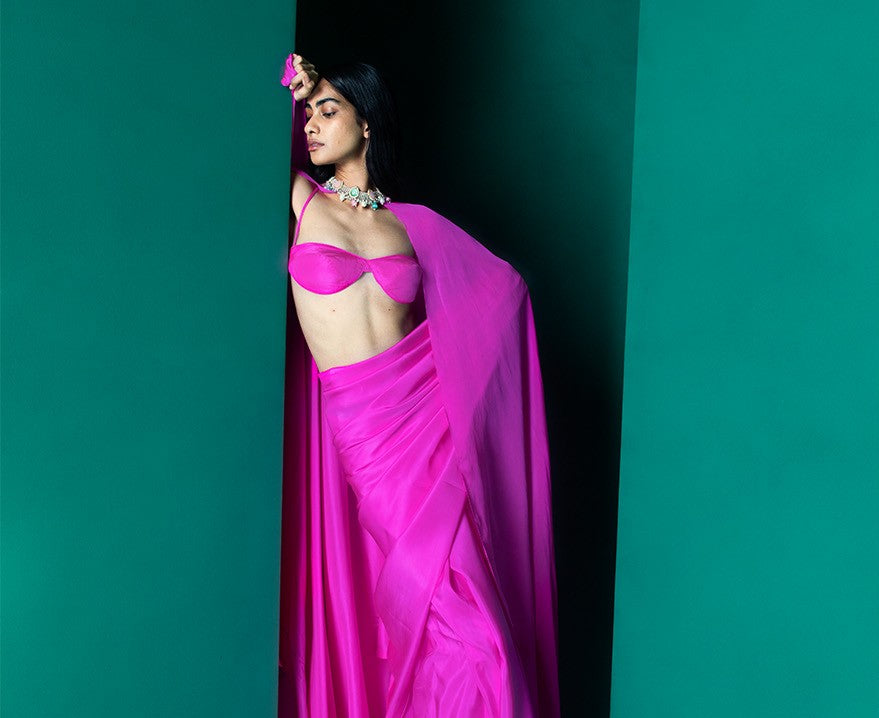India, with its vibrant kaleidoscope of cultures, is a treasure trove of traditional arts and crafts that have been woven into the country's cultural fabric over centuries. Among these, the age-old art of hand embroidery is a key thread in the rich tapestry of Indian handcrafts. This intricate craft skillfully embellishes fabric with needlework, transforming simple cloth into captivating works of art. Hand Embroidery in India is not merely a decorative art; it is a form of expression, a carrier of cultural narratives, and a mirror reflecting the regional identities of its artisans.
Embroidery Designs in India
Hand embroidery in India is deeply rooted in the country's historical and cultural landscape, with each region contributing its unique flavors to this craft. This distinctiveness in style can be attributed to the varying aesthetics, cultural symbolism, and local resources of each region. From the rustic charm of embroidery designs of Kantha work in West Bengal to the shiny and playful mirror work in Gujarat, the delicate and ethereal Chikankari of Uttar Pradesh to the grandeur of Zardozi, Indian embroidery designs offer a plethora of styles and embroidery techniques, each with its unique charm.
Embroidery design is not merely a decorative craft but also a testament to the artisan's skill, patience, and creativity. This art form allows artists to weave stories on fabric, using threads of various hues as their medium. Through intricate designs of birds, animals, flowers, and geometric patterns, artisans tell tales of their land, their culture, and their lives.
Exploring Different Embroidery Designs and Techniques
-
Kantha Work: Originating from West Bengal and Odisha, Kantha work is one of the oldest forms of Indian embroidery design. Characterized by simple running stitches, this style of hand embroidery was traditionally used by rural women to make quilts from old sarees and dhotis. With time, Kantha work has evolved to decorate sarees, kurtas, scarves, and home décor items. The designs often depict everyday activities, flora, fauna, and scenes from ancient Indian epics.
-
Mirror Work or Shisha: This hand embroidery technique, prevalent in the states of Rajasthan and Gujarat, uses small mirrors or 'shishas' embedded in the fabric. The mirrors are secured with a variety of stitches surrounded by beautiful, colorful threadwork. This playful embroidery design technique is commonly used in traditional attire like cholis, lehengas, and even in home decor items.
-
Chikankari: Originating from the city of Lucknow in Uttar Pradesh, Chikankari is a sophisticated and delicate hand embroidery technique known for its sheer elegance. This white-on-white hand embroidery style features intricate floral and paisley motifs, created with a variety of unique stitches. Chikankari is usually done on light, breezy fabrics like muslin, cotton, or chiffon, making it perfect for the hot Indian summers.
-
Zardozi: A Persian term, Zardozi means "gold sewing". Originating from the royal courts of India and Iran, Zardozi hand embroidery uses gold and silver threads, pearls, and precious stones. This form of embroidery design adds an unmatched royal and luxurious touch to outfits, making them a preferred choice for bridal wear and ceremonial clothing.
- Phulkari: Literally translating to 'flower work', Phulkari is a vibrant embroidery design style from Punjab. It involves detailed threadwork, often done in bright colors, depicting floral motifs and village scenes. Traditionally used to adorn head scarves and shawls, Phulkari embroidery designs today are seen on various forms of apparel and home decor items.
Tips for Selecting Embroidery Designs for your Outfits Based on Personal Style and Occasion
Hand embroidery adds a unique touch to any outfit. However, the key to nailing the perfect embroidery design lies in choosing the right style based on the occasion and your personal style. Here are some tips:
-
Casual Wear: For casual events or regular days, go for simple, understated embroidery designs like Kantha or Chikankari on a kurta or saree. These designs add a touch of traditional charm without being over the top. A hand embroidery Chikankari kurti can be a great addition to your summer wardrobe.
-
Party Wear: For festive occasions or parties, opt for outfits with bold and vibrant hand embroidery. Mirror work or Phulkari can add a touch of glamour and drama to your look. An embroidery design on a blouse with mirror work or Phulkari, paired with a simple saree, can make a stylish ensemble.
-
Wedding Wear: For weddings or grand occasions, Zardozi hand embroidery can elevate your outfit. An intricately designed Zardozi lehenga or saree can make you stand out, exuding opulence and luxury. A bridal lehenga adorned with Zardozi embroidery design is a classic choice for Indian weddings.
- Experiment: Don't shy away from mixing and matching different embroidery designs. A Phulkari dupatta with a Chikankari kurta, for instance, could create an interesting fusion look.
Embroidery design is a fascinating form of art that beautifully encapsulates the rich cultural heritage of India. Whether it's the simple charm of Kantha, the playful glitz of Shisha, the understated elegance of Chikankari, or the grandeur of Zardozi, each style of hand embroidery design has a unique appeal. The wide array of hand embroidery designs and embroidery designs patterns allow everyone to find something that resonates with their personal style.


